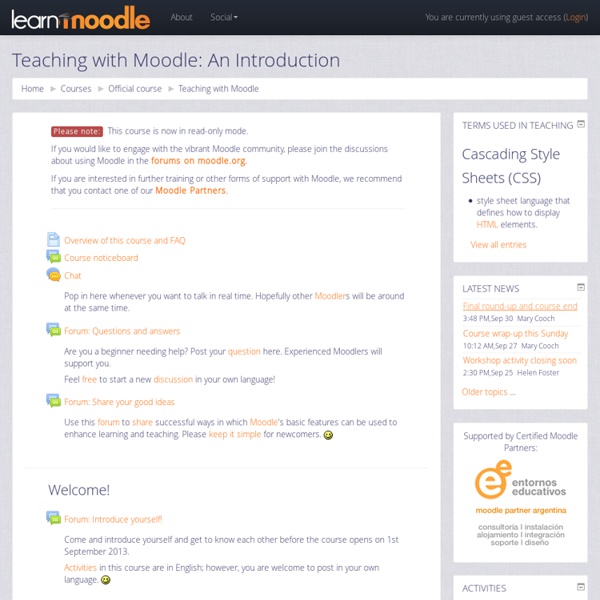



xMOOCs vs. cMOOCs Revisited For reasons known only to the sprites living under the hood of search engines such as Google and Bing, the story on this site that continues to get more search engine traffic than any other is this piece on the distinction between xMOOCs (MOOCs based on professor-centric courses, usually associated with established universities and companies like Coursera , Udacity and edX) vs. cMOOCs (MOOCs based on an earlier connectivist vision of courses involving enrollees acting as both students and teachers). I have still not found a cMOOC to take which would provide the basis for understanding the experience more deeply, but I have been thinking about how the distinction between the two visions of massive online learning may become difficult to maintain as the MOOC experiment continues. Which is as it should be.
Enrichir mon cours Moodle avec les outils du Web The Teaching and Learning Foundations of MOOCs In Daphne Koller’s TED talk about Massive Open Online Courses (MOOCs), she discusses what she believes are the pedagogical foundations of MOOCs. For her, and also restated on the Coursera website (the company she helped found), those foundations include the effectiveness of online learning, mastery learning, peer assessments and active learning. Of course the evidence cited to support these foundations is scant and is quoted without giving any context to the research. MOOC critics also rarely produce any actual evidence when dismissing MOOCs as being pedagogically unsound or when stating that they offer a worse experience than face-to-face education on campus. The MOOC fingerprint The starting point for us was categorising the attributes that define a MOOC as they are presented on platforms such as edX, Coursera and Udacity. The Effectiveness of Online Learning The most obvious characteristic of MOOCs is that they are delivered online. Retrieval Learning Mastery Learning Short Videos
procesos de aprendizaje el futuro de las aulas? MOOC,s examples MOOCs: The cutting announcement of the wrong revolution | betrokken wetenschap A litany of recent complaints shows that something is wrong with higher education: Cost are rising with 10% every year (US), content has lost track with the explosive development of new knowledge, alumni’s competences do not match with the requirements of the labour market, teachers deliver lectures in the same way as their predecessors did for centuries, revenues for society are unclear. 40% of all students are leaving without a grade. Universities are inside looking, fixed at ratings, complacent and self-confident and consequently do not consider any reason for change. According to Christensen[1], universities are on the eve of disruptive innovation. Less than one year ago, the first MOOCs (massive online open course) were launched. However, this is the wrong revolution. The future of the lecture theatre The exchange of lectures for MOOCs does not question the dominance of the acquisition of knowledge in higher education. Learning processes [1] Clayton M.
MOOC, análisis de resultados MOOC, análisis de resultados Enrique Sanchez Acosta Ingeniero de Software en Soft S.A y Doctorando en TI aplicadas (UEM) Ahora que la palabra MOOC empieza a ser conocida por toda la comunidad educativa, se están evaluando los resultados obtenidos por los cursos de prácticamente todas las universidades. La curiosidad que despiertan este tipo de cursosLos conocimientos que requieren para su finalización, que no están siendo filtrados en un principio, debido a la matización de la palabra “Open” en los MOOC. Ilustración 1.- Tasa de abandono de los principales cursos MOOC – Katy Jordan ( Curiosidad En cuanto al primer motivo, “la curiosidad” será solo cuestión de tiempo que comience a desaparecer y se apunten a estos cursos los estudiantes realmente interesados en su finalización, sin embargo, se debe tener en cuenta este factor. Ilustración 2.- Tasa de abandono en las principales plataformas MOOC a) 155,000 estudiantes de 196 países diferentes.
En el mundo MOOC. SCOPEO Informe No. 2. MOOC: Estado de la situación actual, posibilidades, retos y futuro. El pasado jueves 27 de Junio, publicamos el segundo de los informes de SCOPEO sobre la tendencia por excelencia del 2012 en el mundo de la formación Online. Efectivamente, me refiero ineludiblemente a los MOOC, Massive Online Open Courses. Si algo queremos y perseguimos desde SCOPEO, es manteneros al día sobre las últimas tendencias en la formación e-learning, lo hicimos hace 2 años con nuestro Monográfico SCOPEO No.3. Hemos querido tener en cuenta varios pilares en la elaboración de este nuevo informe. En segundo lugar, en el capítulo 2, y teniendo en cuenta que los informes de SCOPEO poseen siempre un componente de análisis cualitativo y/o cuantitativo, hemos reunido a una serie de expertos para realizar un focus group. Por último en el tercer capítulo de este informe, contamos con una novedad. MOOCs, ¿turbocapitalismo de redes o altruismo educativo? Los MOOCs: Una revolución para la transición a la Sociedad del Aprendizaje. Los MOOCs y el aprendizaje de la ciudadanía.